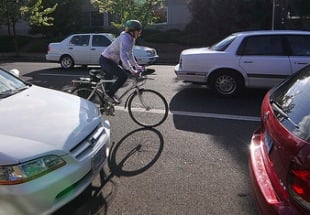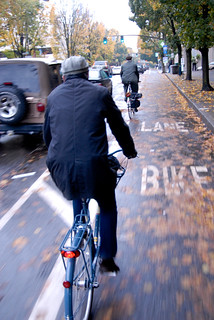
[This story was submitted by Portland resident and active transportation activist Alexis Grant.]
With Jonathan’s recent mention that Effective Cycling (the vehicular cycling bible) will be republished, it seems like a good time to share some thoughts on cycling facilities that I developed after attending Towards Carfree Cities IX in York, UK.
At the conference, I noticed a theme emerging in discussing street configuration: mode separation vs. shared space. Separating modes (like walking, cycling, and driving) means putting them in different places on a street, or allowing them to proceed at different times through an intersection. In the US, we think of separation as normal for people walking. They go more slowly than vehicles, so we give them their own place on the street: the sidewalk. But it wasn’t always so.
“So are the ideas behind vehicular cycling completely useless? I don’t think so… Shared space is the key to moving forward from where we are.”
In her keynote presentation at the conference (PDF here), Dr. Barbara Schmucki explained that at one time, streets were mainly for people walking, with streetcars in their tracks and perhaps a few cars and bikes here and there. Back then, the entire street was shared space. But as motor vehicle traffic increased, walkers were increasingly confined to the sidewalks and intersections, and separation became the norm.
So what about bikes? Should bikes be separated into their own space, or should they share space with cars, or with people walking? Effective Cycling author John Forester and vehicular cycling advocates believe bikes should share space with cars, everywhere and always. No need for separation. It might have worked at one time, but just as for walkers, with more and faster car traffic, it doesn’t work so well now.
In countries like the Netherlands and Denmark, where cycling rates are highest, they don’t consider shared space appropriate for larger or higher-traffic streets and roads. For anyone not steeped in the vehicular cycling mindset, it’s not hard to see why. If someone like me — young, fit, knowledgeable, and confident — shies away from major roads without dedicated space for cycling; how would newer, slower, younger, or older people feel? With cars whizzing by at high speeds, turning, parking, or opening doors in your path, one wrong move or inattentive driver will put you at risk of death.
On larger streets, Denmark and the Netherlands practice separation, installing cycle tracks and bike paths and using signalization that creates separation in time at intersections. For vehicular cycling advocates to oppose this type of careful separation is nonsensical from the point of view of safety and advocacy.
So are the ideas behind vehicular cycling completely useless? I don’t think so. Full separation is expensive, and can’t be done instantly. Shared space is the key to moving forward from where we are, and as part of the shared space model, vehicular cycling still has something to teach us: that bicycles and feet should be respected as legitimate modes of travel and legitimate uses of the roadway, that they can share space with cars and expensive separation isn’t always necessary.
These days, there are new models of shared space emerging. The Dutch “woonerf” (living streets), UK “home zones”, and 20mph speed zones try to slow cars sufficiently that they can share space with riders, walkers, and even kids playing. Streets dead-end for cars while connecting to paths for walkers and riders that take them to the next neighborhood. Bicycle boulevards and neighborhood greenways function as a medium-speed shared space for bikes and cars, where calm riding and calm driving coexist: a local street that still lets you get where you’re going efficiently.
“Vehicular cycling is still the wisest choice in many of today’s road riding environments, and one that will continue to be important in neighborhoods, rural areas, and suburbs around the country for the foreseeable future.”
Shared spaces — both these innovative models and the vehicular style of sharing — are a bridge to a future where mode choice is real. Vehicular cycling is still the wisest choice in many of today’s road riding environments, and one that will continue to be important in neighborhoods, rural areas, and suburbs around the country for the foreseeable future. We can’t complete the transition to new laws and new street geometries overnight, and it’s important for people to be able to ride on any street legally to get where they’re going. And not all streets need full separation; it’s a matter of choosing what’s right for the street size, function, and traffic volume.
We do need to take the time to do the transition right. Much of the resistance to adding special cycling facilities among vehicular cycling advocates came about because in the 1970s and 1980s, such facilities were implemented where they weren’t needed, or because of lack of knowledge or money, were poorly designed and poorly implemented. This isn’t news to anyone who rides. Narrow bike lanes with danger from car doors, poorly-maintained sidepaths with stop signs at every street intersection, and narrow shared off-street paths are still common around the country (and even in Portland). Opposing these bad facilities wasn’t entirely wrong, but the vehicular cycling advocates went about it the wrong way: assuming the concept, not the implementation, was wrong.
We don’t have to become Amsterdam overnight for bicycling to be a comfortable and dignified way to travel. But vehicular cycling and shared space are not the One True Way, and that’s where vehicular cycling advocates overreach. Today’s separated street designs are far better than they were thirty years ago, and it’s time for them to stop opposing forward movement. Separating modes allows safe and efficient travel for all through high-demand corridors such as commercial districts, major highways, and local pinch points like bridges and tunnels. It allows everyone to feel comfortable and enjoy using active modes to get around, whether they are old or young, male or female, fast or slow. Done right, it increases safety, increases cycling rates, and makes riding more fun. Now that’s effective cycling.
[Read more reader stories here.]


